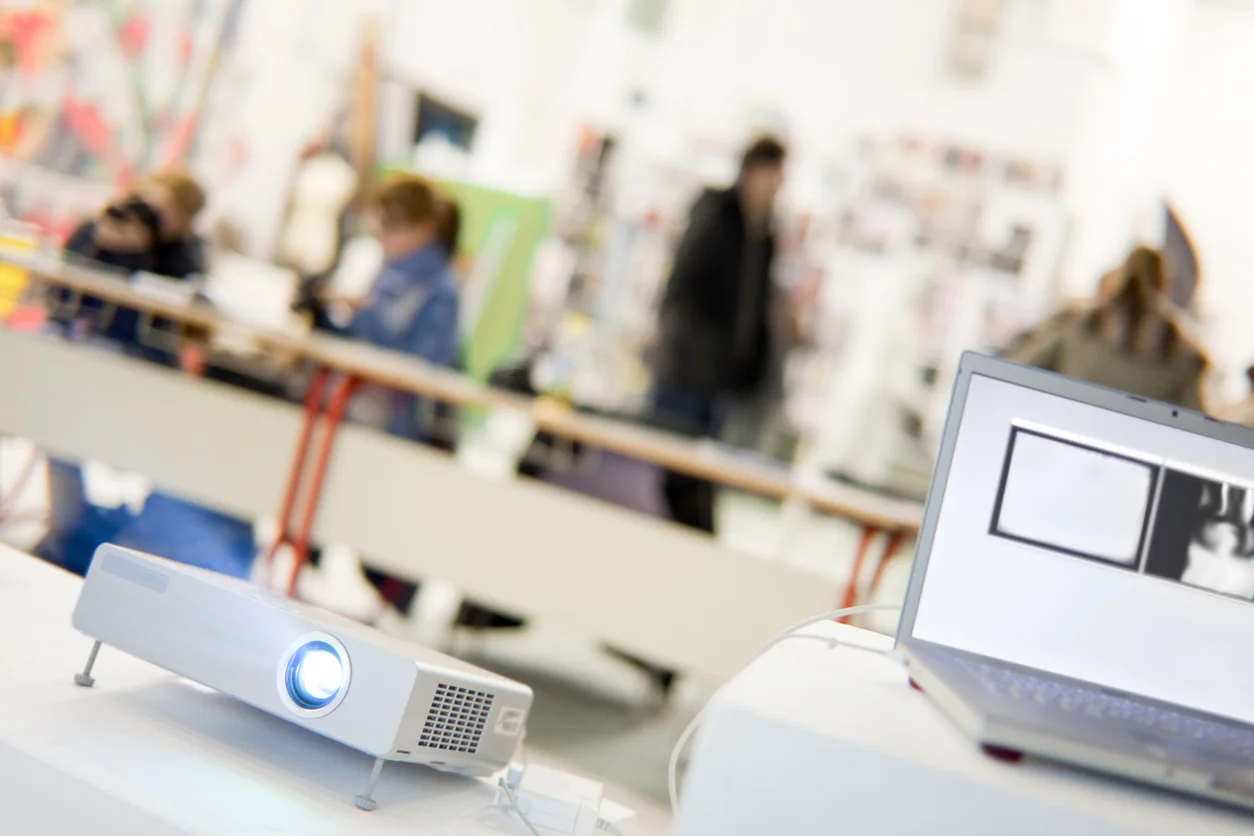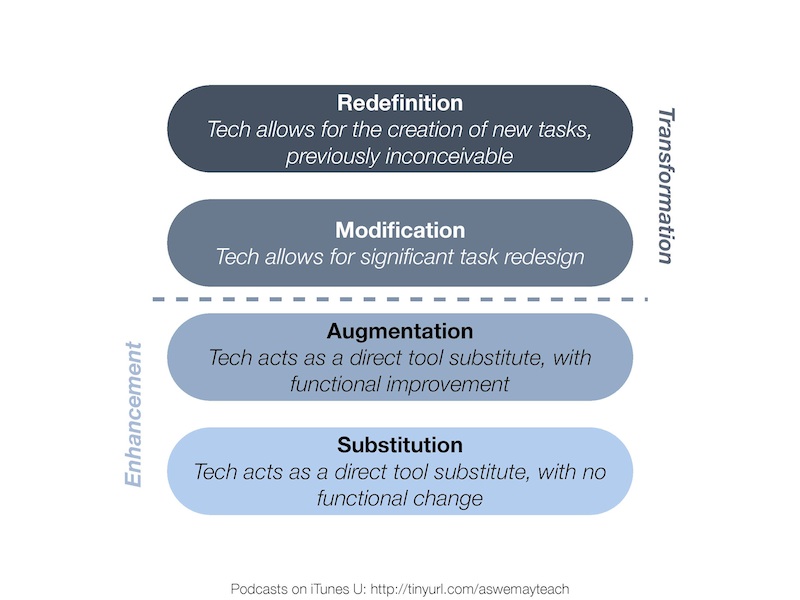I believe we are in a transitional stage with technology; A place where adoption is hindering general productivity. We know when we have achieved successful technology integration: it is when we use technology without even thinking about it. When you make a telephone call with your mobile phone, rarely do you think about the process of unlocking, filing through names and tapping the green "call" button. You likely never wonder at the marvel of taking a photograph and sharing it with a friend. These processes are ingrained and simple. The devices we use are all around us, they are ubiquitous and the outcomes obtainable.
Technology's presence in education should be no different. I despair at the complexity of some tasks which should be ingrained into us. Creating voice memos, editing pictures, creating video, sharing and collaborating with your colleagues on a global scale. Tasks like these can assist the teaching and learning process, these workflows can aid in the retention of information. Ultimately these tasks will be expected of students as they enter university and the workforce.
Borrowed from an expert called Dr Rueben Puentedura the term "Transformation" as a result of technology adoption, is a stage you want to aim for in your journey.
The SAMR model.
Dr Rueben Puentedura hit on a model which you should be familiar with. The SAMR model is a system which you can use to measure your application of technology, or it's level of use.
The first level is the lowest level of use: Substitution.
Technology acts as a direct tool substitute with no functional changes. A common example is a type-writer being exchanged for a word-processor (albeit with a screen) and being used in exactly the same way. No cut and paste, no spell check, just direct substitution.
The next level is: Augmentation
At this level you are using the same tool with some functional improvement. Improvements may include the spell check or instant dictionary definition, cut/paste and placement of images etc. Already at this secondary stage we are seeing a much higher level of productivity from the individual.
The third level is: Modification
This level actually slightly alters (but doesn't change) the task at hand. For example, beforehand your type-writer was being used to produce a text report. But now we have additional technology tools available, we could create the report in a spreadsheet. This would allow you to automatically calculate sums and create graphs for immediate visualisation of the information. We may choose to email the spreadsheet to colleagues instead of print it. Our report (previously a fixed paper document) has now seen significant task redesign. This results in substantial productivity increase.
The fourth level is known as: Redefinition.
At this level, we look beyond ways of just modifying the process **which still has the fundamental task at its heart**. Is this the best way to perform the task? The Redefinition level will use available technology to completely redesign tasks.
We are no longer producing a simple report. Information that would original have been compiled by an individual could now involve many contributors; collaborating in real time on the same document. An example might be to use a public document on Google Docs allowing for instant global collaboration on the project. The project could include photographs, graphics, even video, added from many different devices. Spreadsheet calculations will cascade through a document and be available for all decision makers in a moment. Immediately the task has seen the removal of multiple steps, and many more users are viewing and editing the document, increasing communication, accuracy, and productivity.
Applying this model into education is having astounding results. It is a fairly simple idea but one which has really helped me to evaluate where I am at, and what I could be achieving. But it can also be used to gauge your schools level of technology use, and to measure the success of your investment.
All too often I hear, "But this is the way that we have always done it!". And that is the statement that you may come across as you move from modification to redefinition and try to change the actual task at hand. But I would encourage your teachers to let go and put faith into new technologies and software. The Redefinition stage, in many instances can be the easiest to apply but the hardest to instigate.
As fate should have it Dr Rueben Puentedura visited Australia just a few weeks ago. He gave some great advice for those that choose to adopt the SAMR model in education:
Dr Puentedura introduced a simple method to introduce the SAMR model to staff in the form of a short PD opportunity where a teacher can discover and begin to understand the model better. Dr Puentedura displayed this brilliant slide introducing the SAMR Ladder, and offered the following advice.
Ask your teaching colleagues to create a SAMR Ladder so that they can visualise/plan their progress. Once your colleagues identify a task which they are performing at the substitution level, it helps them to recognise ways that they can enhance that task.
It is sometimes appropriate to maintain teachers at the substitution/augmentation stage for a long time, these enhancement levels are good. But you must treat these levels as transitional levels. It is not ideal to stay at the enhancement levels, as technology evolves we must evolve too.
At the modification level ask your colleagues, "What is it that you have always wanted to accomplish in terms of educational goals that you couldn't accomplish before?". This is a big question, and one which you may need to offer some guidance on. By keeping the core of the task the same but applying clear changes to certain aspects involving modern technology, (software or specific apps for example) can we accomplish those goals that the teacher would like to reach?
Finally, Is there a way that we could accomplish those original goals but with a different task? By actively replacing your original task with a new more efficient one, you will find that the underlying concept of the task itself becomes apparent. The student can explore concepts a lot deeper then previously.
I would add that task redefinition can also remove constraints that may have existed before but where not addressed. At redefinition the task and its outcomes are clearer, the technology becomes invisible and the learning at hand takes priority. My example earlier in this article: making a telephone call on a mobile phone demonstrates how a task can be transformed, simplified and made accessible for all.
The irony in the mobile phone call example is: the symbol which represents our phone call is still an old analogue handset. We may be even making a video call, but we still press the "handset" icon. I guess old habits die hard.
I encourage you to visit Dr Rueben Puentedura's blog at www.hippasus.com to discover more.
Dr Sarah Howard
Just a few weeks ago I was fortunate enough to listen to Dr Sarah Howard speak at an Adobe education conference. Dr Sarah Howard is a lecturer in ICT and Education at the University of Wollongong and has been evaluating the Digital Education Revolution in secondary schools across NSW.
One of the things which Dr Sarah Howard has discovered in her research (focused on intern teachers in New South Wales) is that most teachers still have very low levels of digital literacy. Her data has indicated that the assumption sometimes made: that young teachers are Digital Natives, is not correct.
Technology is used a lot but only in low level uses (ie Facebook, and Google search). If asked to perform a "complex" task such as creating a presentation or editing a photograph most teachers would come unstuck.
Dr Sarah Howard concluded that in teacher education not enough is done to raise these essential skills. Teachers are simply not exposed to these sorts of tasks, these digital literacies are not brought into the concept of teaching enough, if at all. The teacher identity itself needs to be re-addressed, it is not enough to simply say "I'm not a techie person, this is not part of my job role".
We have a duty to prepare students for a future where technology use is a given, and we need to empower teachers correctly. But we can be clever about this. Put the pedagogy first and carefully consider the goals of the teacher. Provide a solution which enhances the learning outcomes and doesn't obstruct or distract.
It is because of this that your Technology Integration Specialist should perhaps be considered more of a Curriculum Integrator (enhanced by technology).









